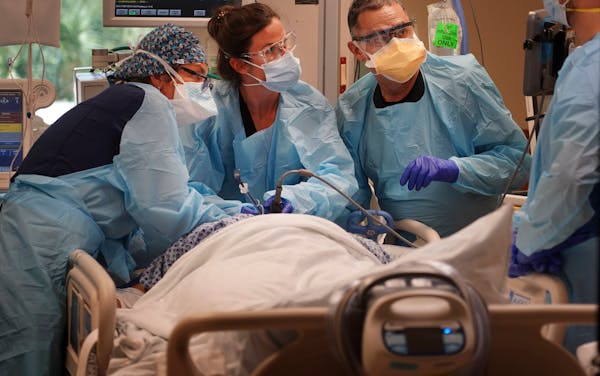COVID-19 hospitalizations have increased to 696 in Minnesota, which for the first time in the pandemic is reporting that more than 95% of staffed intensive care beds are filled.
While COVID-19 hospitalizations remain below the peaks in prior pandemic waves of 699 in April and 1,864 last November, hospital leaders said they are combining with seasonal trauma injuries and other urgent medical needs to stretch critical care resources.
ICU usage rates above 90% are common in Minnesota, especially in winter flu seasons, but have been steadily increasing since early August along with the latest pandemic wave fueled by a delta variant of the coronavirus that causes COVID-19.
The state's MNTrac monitoring system on Friday reported that 1,151 of 1,206 available ICU beds were occupied by patients with COVID-19 or other unrelated medical concerns — a usage rate of 95.4%.
"Hospitals, by in large, are full," said Dr. Paul Mueller, vice president of Mayo Clinic Health System, Southwest Wisconsin, in an online forum Friday morning to address vaccine misconceptions.
The Minnesota Department of Health on Friday reported 18 COVID-19 deaths and 2,050 coronavirus infections, raising the state's pandemic totals to 7,892 deaths and 666,496 infections. While 87% of Minnesota's COVID-19 fatalities have involved people 65 or older, the additions on Friday included two people in their 40s from Anoka and Freeborn counties.
The state Health Department could not identify how many of the latest cases or the 696 people hospitalized with COVID-19 were vaccinated or unvaccinated. While the state provides a weekly report on breakthrough infections in fully vaccinated Minnesotans, health officials said they cannot provide that information on a daily basis because of delays in syncing infection and vaccination records.
About half of U.S. states report some form of breakthrough infection data, but none provide a daily breakdown of hospitalizations by breakthrough status. Some hospital systems report the information individually, though. Minneapolis-based Allina Health earlier this week provided data upon request showing that 37 of 149 patients with COVID-19 in its hospitals had been fully vaccinated.
Two studies with Minnesota ties were released Friday by the Centers for Disease Control and Prevention showing some slippage in vaccine effectiveness amid the rise of the delta variant but strong protection against hospitalizations and deaths.
The Minnesota Department of Health contributed to a 13-state study showing that unvaccinated people made up 95% of infections and 93% of COVID-19 hospitalizations from April 4 to June 19 but 82% of infections and 86% of hospitalizations at the start of the delta variant surge from June 20 to July 17. Even so, hospitalizations remained 10 times less likely in the vaccinated population.
Researchers from Bloomington-based HealthPartners co-authored a nine-state study during the delta wave that showed the three available vaccines were 86% effective at preventing hospitalizations and 82% effective at preventing emergency room or urgent care visits for COVID-like illnesses.
"Overall, it's reassuring to see that, even in this era of the delta variant predominance of COVID-19, the vaccines ... are highly effective," said Dr. Malini DeSilva, a co-author and research investigator at the HealthPartners Institute.
State health officials urged more COVID-19 vaccinations — with Gov. Tim Walz visiting K-12 schools for the fourth day in a row Friday to welcome children back to classes and encourage more immunizations in a student population that could serve as a source of viral transmission.
Mayo's Dr. Gregory Poland urged unvaccinated people to seek shots and not be dissuaded by the paradox of rising breakthrough infection rates, which are expected to increase and would ultimately reach 100% if all people were vaccinated.
"We will expect this number to climb and climb and climb as we vaccinate more and more people for the simple reason that the only people left to get disease are people who are vaccinated," said Poland, director of Mayo's vaccine research group. "It does not mean the popular lay interpretation that the vaccine doesn't work."
More than 72% of eligible Minnesotans 12 and older have received at least first doses of COVID-19 vaccine. The rate increases to more than 92% in more vulnerable senior citizens but drops below 60% in eligible teenagers, who are at substantially lower risk of severe COVID-19 illness but can spread the virus to others.
Another encouraging sign in Minnesota is the continued leveling of the positivity rate of diagnostic testing at 6.6% — raising hope of a quick peak to the delta-fueled wave that has occurred in other countries. The rate remains above the state's 5% caution threshold for substantial viral spread, but hasn't increased in 12 days.
Two influential pandemic models by Mayo and CDC also predict slow or no COVID-19 growth in Minnesota in the short term. Mayo forecasts more rapid growth in Iowa and North Dakota, but that Minnesota's rate of daily coronavirus infections will increase from a rate of 31 per 100,000 people to 35 in two weeks.
State health officials said they are closely monitoring to see if the start of K-12 classes or large events such as the Minnesota State Fair will upset recent progress.
The rising number of hospitalizations at a time of modest infection growth isn't a surprise based on earlier pandemic waves. Trends in hospitalizations and COVID-19 deaths have tended to lag two to four weeks behind trends in infections.
In the first spring 2020 wave, Walz used his emergency authority to order a delay of non-urgent procedures in hospitals to conserve bed space and protective equipment such as masks and gowns that were in short supply.
Hospitals issued similar delays on their own during the fall 2020 wave but haven't broadly used such measures in the latest wave.
Jeremy Olson • 612-673-7744

Souhan: Wolves fans made Game 1 special. Now bring on Game 2.

Kao Kalia Yang, Edel Rodriguez and others bring us gorgeous new picture books
Tip sparks new search for Blaine woman who went missing 30 years ago

